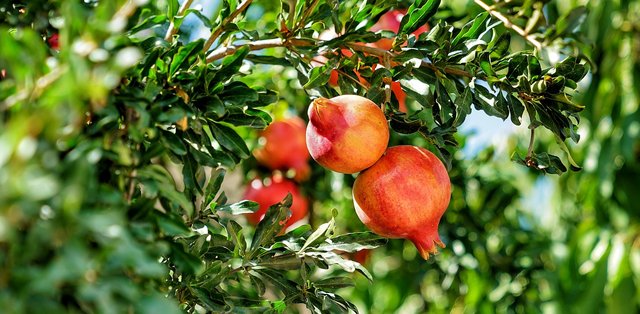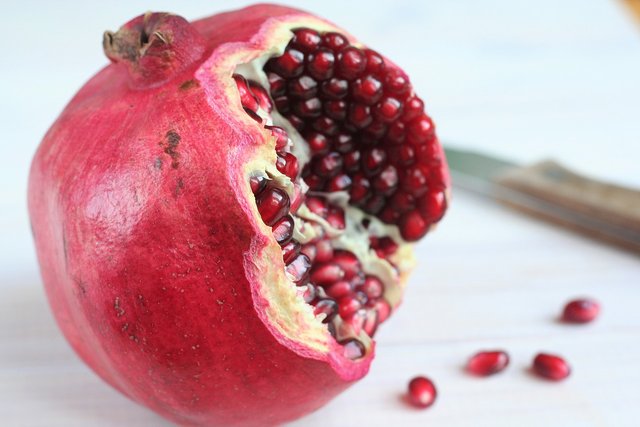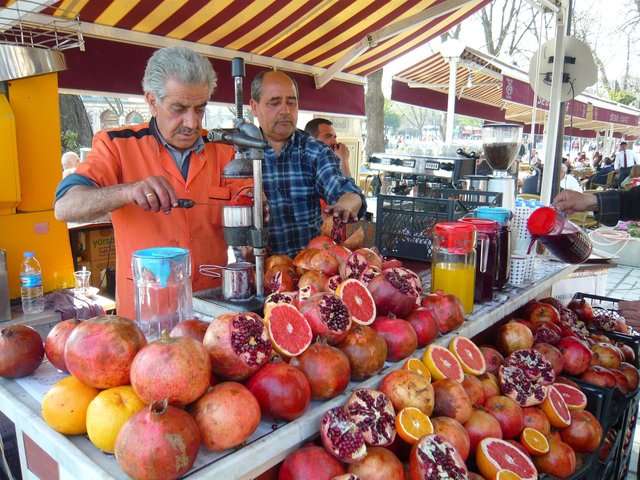Everything You Ever Need To Know About Pomegranates 😍 (Drew's Digest #03)
Pomegranates have often been touted as the latest superfood, and with good reason. The tiny red treasures found inside the fruit are packed with vitamins and rich in antioxidants, and not mention are addictively sweet!
Where do they come from?
The fruit-bearing tree, Punica granatum, which translates to “seeded apple” originated from Iran and has been cultivated for food and decorations for hundreds of years by different cultures.
Thought to possibly be one of the oldest known fruits, pomegranates appear in Greek mythology, the Bible and other religious and historical texts; often seen as a symbol of fertility 👶

What are they exactly?
The outside of the red fruit is leathery and has a sort of round hexagonal shape which can vary in size, but the inside is where all the action is. The white spongy membranes that divide the fruit into compartments are bitter and not commonly eaten. The content of each compartment, however, is what we are after, the edible portion known as the arils.
The sweet red arils that encase the seeds are covered by a gel-like transparent coating. The seed itself is soft and slightly crunchy, mostly going unnoticed when eaten raw.

When are they available?
In Australia, pomegranates are in season and available from around April through August, and often imported as punnets of pre-popped arils when not in season for convenient use. They are extremely hardy plants and can be grown almost anywhere due to their drought and frost tolerance ❄️
How do I use them?
The first step in retrieving those delicious arils is the de-seeding process. Many methods have been employed (like the whack technique) or the water approach; it really depends on how messy you want to get. Here is a clip of Jamie Oliver spanking a little pomegranate 🎁
If you want to try another method, simply remove the blossom (pointy open end) and cut the fruit into wedges. Work the seeds out with your fingers either above a bowl of water or whilst submerged, allowing the arils to sink to the bottom. The white membranes will float, so just scoop out them out and strain the arils. They can be stored in the fridge for up to 5 days or frozen for later use.
Pomegranates are most commonly consumed raw, as a juice and sometimes dried. Juices are becoming super popular in supermarkets and used as either a stand-alone drink or in soups, like the traditional Iranian dish, Āsh-e anār. Raw arils are great in salads to add that slight level of sweetness and crunch, or even in desserts.
Did you know?
The popular syrup, grenadine, that is used as a cocktail mixer was originally made from pomegranate juice, sugar, and water. But is nowadays made from a mixture of artificial flavours and colours, rather than natural fruits, in order to reduce production costs 💁
Why should I eat them?
The reason for the rise in popularity of pomegranates stems from their high antioxidant and polyphenol properties. Not only that, but just half a cup of arils can provide you with 3.5 grams of fiber and around 20% of your daily requirements for Vitamin K and C 👍
Antioxidant levels in concentrated and commercial juices (i.e. containing arils and tannins from the rind of the fruit), were found to be up to three times higher than red wine and green tea!

What do antioxidants do though?
The role of antioxidants in our diet is helpful for preventing and reducing the damaging effects of reactive oxygen species (ROS). Put simply, ROS are formed when oxygen binds to molecules in our bodies, as a result of exercise, metabolism, smoking, and alcohol (i.e. basically anything that introduces oxygen to the body).
Although ROS are essential for some cellular mechanisms to function, when too much accumulates, the body is exposed to oxidative stress which can lead to degenerative conditions, cancers and accelerated ageing. And none of us want to age any faster than we already are 👨⚕️
More specifically, studies have found that antioxidants and other phytochemicals (beneficial plant chemicals) found in pomegranates can;
- reduce the risk of prostate cancer in males
- assist and enhance breast cancer treatment drugs
- help manage Type-2 diabetes by increasing insulin sensitivity
Much more research has been and continues to be done on the powerful medicinal effects of pomegranates. There is a reason why humans have eaten them for so long. Mostly because they are delicious, but also for the health benefits.
Thank you so much if you got this far. I truly appreciate you taking the time to digest some of my content 😁
Images are my own, sourced from Pixabay or linked
Drew's Digest #02 - How Genetics Will Define Our Future Diets 👨🏻🔬
Drew’s Digest #01 - Everything You Ever Need To Know About Avocados 🥑
Drew! Wow what an awesome post! You have gotten some awesome attention as well!! Incredible! Keep it up!
Thanks man, appreciate it. Loving this platform. #teamaustralia for the win ✌🏼🇦🇺
I can't thank you enough @steemstem, what a boost this has given my post and page!! Long live steemstem..
@originalworks
The @OriginalWorks bot has determined this post by @thedrewtrott to be original material and upvoted it!
To call @OriginalWorks, simply reply to any post with @originalworks or !originalworks in your message!
Very informative post....thinking of adding a glass of pomegranates juice in my diet on regular basis
Absolutely! I like juicing around half a pomegranate with an apple, it's a great combo but very sweet. 😁
Only just started following you @thedrewtrott and already I am enjoying your blog. Great peices, easy to read and digest. Glad I found your blog.
Keep it up.
tip!
Hi @thedrewtrott! You have received 0.1 SBD tip + 0.02 SBD @tipU from @moonunit :)
from @moonunit :)
Check out new tipuvote! feature :)